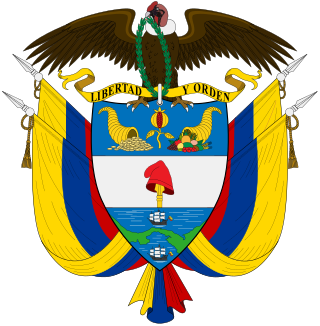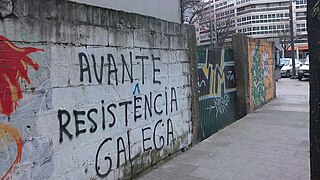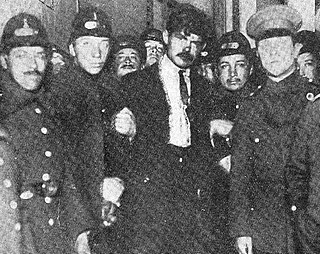
The Comando Jaramillista Morelense of May 23 is a rebel group in Mexico, attached to agrarian and leftist thoughts, taking the name of the agrarian leader and militar Rubén Jaramillo. His operation is a classic armed propaganda action that fulfilled one objective: to disseminate the existence of the command and its ideology. An initiative carried out at a time of profound political decomposition in the rest of the country, preceded by the making of paintings that gave account of the existence of the group in different parts of the states of Morelos.

This is a timeline of events related to the Colombian conflict.

Resistência Galega, sometimes referred to as REGA, is the term used by a series of left-wing and Galician separatist organisations and individuals to claim attacks in Galicia. The term was first used in 2005 when a manifesto named Manifesto da Resistência Galega appeared on the Internet. Since then, Resistência Galega has carried out dozens of attacks against political party offices and banks across Galicia.
A series of bomb attacks, which continued as of 2014 with about 200 bombs up to that date, started in the capital of Chile, Santiago, in 2005.
Terrorism in Argentina has occurred since at least the 1970s, especially during the Argentine Dirty War, where a number of terror acts occurred, with support of both the democratic government of Juan Perón, Isabel Perón and the following de facto government of the National Reorganization Process. In the 1990s, two major terrorist attacks occurred in Buenos Aires, which together caused 115 deaths and left at least 555 injured.
Terrorism in Ecuador is a rare occurrence as the country, despite recurrent periods of economic and political instability, has been traditionally known as a peaceful state in Latin America, unlike its neighbor states; Peru and Colombia, which have suffered widespread violence by insurgent, paramilitary and drug trafficking organizations in different degrees for more than fifty years.

The anarchist movement in Chile emerged from European immigrants, followers of Mikhail Bakunin affiliated with the International Workingmen's Association, who contacted Manuel Chinchilla, a Spaniard living in Iquique. Their influence could be perceived at first within the labour unions of typographers, painters, builders and sailors. During the first decades of the 20th century, anarchism had a significant influence on the labour movement and intellectual circles of Chile. Some of the most prominent Chilean anarchists were: the poet Carlos Pezoa Véliz, the professor Dr Juan Gandulfo, the syndicalist workers Luis Olea, Magno Espinoza, Alejandro Escobar y Carballo, Ángela Muñoz Arancibia, Juan Chamorro, Armando Triviño and Ernesto Miranda, the teacher Flora Sanhueza, and the writers José Domingo Gómez Rojas, Fernando Santiván, José Santos González Vera and Manuel Rojas. At the moment, anarchist groups are experiencing a comeback in Chile through various student collectives, affinity groups, community and cultural centres, and squatting.
On 17 January 2019, a vehicle was driven into the General Santander National Police Academy in Bogotá, Colombia. The truck forced its way into the facility, hit a wall and detonated, killing 22 people and injuring 68 others. Suicide attacks are unusual in Colombia. The car contained about 80 kilograms (180 lb) of pentolite. It was the deadliest attack on the Colombian capital since the 2003 El Nogal Club bombing and the first terrorist attack on the capital since the 2017 Centro Andino bombing. The National Liberation Army (ELN) accepted responsibility for the attack and justified it as a response to the bombings made by the Colombian government during the unilateral ceasefire.
The Anarchic Cell For Revolutionary Solidarity was an anarchist urban guerrilla group that was active in the city of La Paz, where it carried out several explosive attacks in the first half of 2012, causing material damage.

The Práxedis G. Guerrero Autonomous Cells of Immediate Revolution was an anarchist urban guerrilla group that centered its attacks in the metropolitan area of the Valley of Mexico, extending some attacks to neighboring states. This group, along with a dozen other cells, came to be considered a serious threat to the stability of the Mexican capital according to publications made by CISEN.
The Revolutionary Cells were an urban guerrilla group created in mid-2009 in the metropolitan area of Buenos Aires, being responsible for several arson attacks and explosive attacks against government buildings, transnational offices and "bourgeois structures".

The Severino di Giovanni Antipatriot Band was an urban guerrilla in Santiago, responsible for several arson attacks and explosives. The name was inspired by Severino di Giovanni, an Italian anarchist, journalist, worker and poet who died in Buenos Aires in 1931.

The Efraín Plaza Olmedo Dynamite Band, also known as the Dynamite Gang, was an urban guerrilla group active in Santiago, and known for its attacks against banks and the Hotel Marriott Santiago de Chile. The group named themselves after Efraín Plaza Olmedo, a Chilean anarchist responsible for a shooting that on July 14, 1912, fired at a crowd in the heart of Santiago, killing 2 young men from the wealthy class. He justified his attack as "a way to attract the attention of the people for their misery and the egotism of the bourgeoisie." He was sentenced to 40 years in prison. He was released in 1925, but was found dead days later without knowing if it was a suicide or if he was murdered.

The Antagonic Nuclei of the New Urban Guerrilla is a Chilean armed group created in mid-2011, active in the Santiago Metropolitan Region attached to insurrectionary anarchist theories, being responsible for several attacks in recent years.

Individualists Tending to the Wild is a self-defined eco-extremist group that emerged in Mexico in 2011. The Mexican authorities have attributed some violent actions to it, but most of the attacks claimed by the group have been denied after judicial investigations and attributed to other groups or crimes other than terrorism. The lack of a task of contrasting information by the media has led to any violent action claimed by ITS reaching public opinion.
The Vandalika Teodoro Suárez Gang was an Argentine urban guerrilla group active in the metropolitan area of Buenos Aires, from 2010 to 2011, where it launched attacks on banks and offices belonging to private companies.
The Iconoclastic Caravans for Free Will were an anarchist cell active in the Santiago Metropolitan Region, being known for some attacks in the communes of Las Condes and Vitacura. The group gained attention from the authorities for its members being closely investigated during the investigation of the Bombas Case.
The Leon Czolgosz Autonomous and Destructive Forces, were a Chilean anarchist cell formed in September 2006, known for its attacks against the National Intelligence Agency of Chile and the British embassy in Chile. The name of the group was in honor of the American anarchist Leon Czolgosz, who on September 6, 1901 assassinated then-United States President William McKinley with two bullets at point-blank range.

The Revolutionary Anarchist Front was an urban guerrilla group that was active in the Santiago Metropolitan Area, responsible for various sabotage, arson and explosive attacks. The group gained media attention for the attacks it carried out and was awarded.

The attacks on the northern border of Ecuador in 2018 were a series of terrorist attacks that took place in the towns of San Lorenzo, Mataje and Viche in the Esmeraldas Province, Northern Ecuador. The attacks began on January 7, 2018, outside the facilities of the San Lorenzo National Police district where, in the early morning hours, a car bomb exploded leaving 28 people injured, as well as severe damage to the infrastructure of the police precinct and 37 homes in the vicinity. In preliminary investigations, Ecuadorian authorities linked this incident to criminal organizations linked to drug trafficking and the illegal drug trade.










